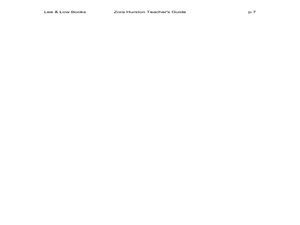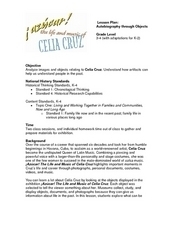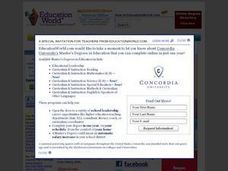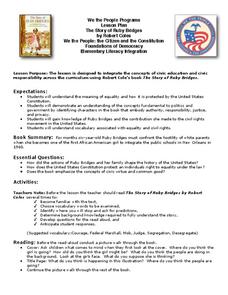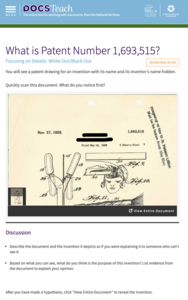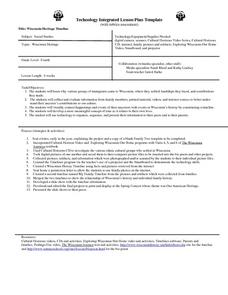Curated OER
What Is Happening in Haiti?
Students discuss the 2010 earthquake in Haiti and empathize with the victims of the disaster. In this 2010 Haitian earthquake lesson plan, students learn about the history and hardship the country has consistently faced. They watch clips...
National Park Service
A Tale of Two Men
Theodore Roosevelt and the Marquis de Mores were both born in 1858, and both came to the Dakota territory in 1883, but they influenced the developing country of America in different ways. Elementary and middle schoolers apply written and...
Curated OER
Recycled Greeting Cards
Students create greeting cards from recycled products. They research how paper is recyled and the history of paper. They write free verse and create their own recycled paper. They use Microsoft Word to write their final drafts of verse...
Curated OER
Home Sweet Home
Students complete activities with the books Color Me Dark, The Diary of Nellie Lee Love, and The Great Migration North. In this literature/History lesson plan, student read the story and discuss the plot. They analyze photographs...
Curated OER
Zora Hurston Teacher's Guide
Students explore American culture by reading classic literature in class. In this African-American history instructional activity, students read the story Zora Hurston and the Chinaberry Tree while identifying the work and contributions...
Curated OER
Dinosaur History (Part 4)
Students read the scripture that cooresponds with this lesson on dinosaurs. Using the text, they determine the types of animals on the ark with Noah. They identify the factors necessary for fossil formation and discuss how the ark...
Curated OER
Susan B. Anthony Day
The history of women's suffrage and Susan B. Anthony are examined in this social studies activity. Third and fourth graders participate in a simulation of a vote, develop slogans for women's suffrage, complete a KWL chart, write a...
Alabama Department of Archives and History
A Worse Death: War or Flu?
In a lesson plan that integrates history and mathematics, class members create graphs that compare military death statistics from World War I with those that resulted from the influenza pandemic of 1918.
Curated OER
Learning Through Autobiographical Situations
A special education classroom examines a variety of literature from Latin American authors. In groups, they read excerpts from many autobiographies and compare them with their own life. After writing their own autobiographies, they...
Curated OER
National Craft Month
Incorporate National Craft Month into your daily lessons with these great ideas.
Curated OER
American Symbols and Figures
Students examine a variety of symbols important in American culture. They investigate the history of the Great Seal of the United States and the painting "The Spirit of 1776". They create an original seal and identify important monuments.
Smithsonian Institution
Autobiography through Objects
Show youngsters how objects can tell a story! Here your class will learn about Cuban salsa dancer Celia Cruz by analyzing pictures of her dress, her shoes, and her marriage certificate. After describing Cruz's items and imagining what...
Curated OER
Celebrate With Silhouettes
Students explore history of silhouettes, and help create keepsake silhouettes, frame them, or use them to make a special Mother's Day card.
Curated OER
Huichol Yarn Painting
Young artists of many ages apply yarn painting techniques in combining their ideas and their art. After viewing actual examples of yarn paintings created by the Huichol people, learners choose an important scene from their own lives...
Curated OER
Note Taking By Crayon
Skim a brief biography of Amelia Earhart with your class, and then assign groups of researchers one of four topics listed: Amelia's family life, important airplane flights during Amelia's life, turning points in Amelia's life, and...
Curated OER
We the People: The Citizen and the Constitution
Robert Coles’ The Story of Ruby Bridges forms the basis of this powerful cross-curricular study of civic education and civic responsibility. Class members consider how the book presents authority, responsibility, justice, and privacy.....
DocsTeach
What is Patent Number 1,693,515?
Scholars examine a document from 1928 featuring a mystery invention. Following their observations and discussion, the document reveals the invention of the permanent wave machine by Marjorie S. Joyner. Class members read about Joyner,...
Curated OER
Immigration and Ancestors
We are all immigrants to this country and the study of immigration can help students connect to history in a personal way. Students will listen to audio clips from the Ellis Island web site, discuss the treatment of immigrants in the...
United Nations
Peace Worksheets
Children are the voice of the future—and they are the best chance the world has for international peace. Help them secure peace in their lifetimes with a lesson based on the history of the United Nations, which includes a space for...
Curated OER
Veteran's Day or Memorial Day Poetry Lesson
Students examine poems dealing with Veteran's Day or Memorial Day. They discuss America's involvement in wars and if anyone in their family has served in the military. They write their own poems and share them with the class.
Curated OER
Wisconsin Heritage Timeline
Fourth graders explore why groups of immigrants settled in Wisconsin. Through intervies with family members, printed materials, and internet research, 4th graders discover the contributions early residents made to the state. Students...
Curated OER
Growth in Southern California
Fourth graders examine the impact of orange crops and the railroad industry on the growth in southern California. They develop a fact list about the history of oranges in California, and create a family tree demonstrating the impact of...
Curated OER
Beijing: An Important City in China
Students investigate Beijing by reading an essay. In this Chinese Geography lesson plan, students read an essay written about Beijing and answer questions on a comprehension worksheet. Students may research Beijing further by...
Curated OER
Who Needs It?
Fourth graders explain the needs and wants of an Abenaki family or group and/or of a family or group in the first half of the 19th century and compare them to the needs and wants of Students' family or household today.




